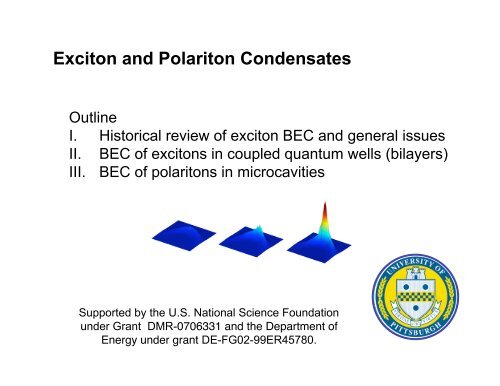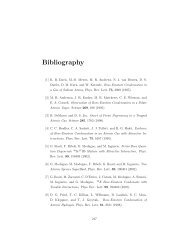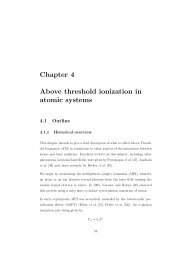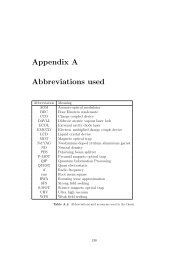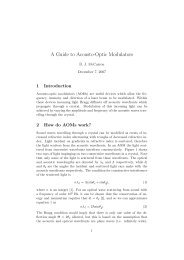Bose-Einstein condensation of excitons and polaritons
Bose-Einstein condensation of excitons and polaritons
Bose-Einstein condensation of excitons and polaritons
Create successful ePaper yourself
Turn your PDF publications into a flip-book with our unique Google optimized e-Paper software.
Exciton <strong>and</strong> Polariton Condensates<br />
Outline<br />
I. Historical review <strong>of</strong> exciton BEC <strong>and</strong> general issues<br />
II. BEC <strong>of</strong> <strong>excitons</strong> in coupled quantum wells (bilayers)<br />
III. BEC <strong>of</strong> <strong>polaritons</strong> in microcavities<br />
Supported by the U.S. National Science Foundation<br />
under Grant DMR-0706331 <strong>and</strong> the Department <strong>of</strong><br />
Energy under grant DE-FG02-99ER45780.
General concepts <strong>of</strong> <strong>excitons</strong><br />
quasi number conservation. Cf. proton decay <strong>and</strong> H atom BEC<br />
crossover: quasiequilibrium BEC ! nonequilibrium BEC ! immediate decay<br />
incoherent<br />
phonon<br />
emission<br />
photon emission: weak probe <strong>of</strong> instantaneous energy <strong>and</strong> momentum<br />
distribution<br />
conduction states<br />
valence states<br />
“Wannier” limit: electron <strong>and</strong> hole form atom<br />
like positronium that has center <strong>of</strong> mass velocity<br />
Excitonic Rydberg: Excitonic radius:<br />
" = " Ps<br />
! 2<br />
a = !a Ps
Prehistory <strong>of</strong> exciton BEC<br />
early, independent predictions: Moskalenko 1959, Blatt 1962<br />
early mean-field theory: Keldysh <strong>and</strong> Kozlov, 1967<br />
Nozieres <strong>and</strong> Comte, 1982<br />
Early focus was on bulk semiconductors with deeply bound <strong>excitons</strong><br />
(Rydberg ~ 100 meV)<br />
•nearly impossible to exceed Mott density with 3D tightly bound (~ 5Å)<br />
<strong>excitons</strong><br />
•direct gap semiconductors: no electron-hole liquid (EHL) phase<br />
(analogous to liquid hydrogen)<br />
• in principle can have BEC in indirect-gap semiconductors on short<br />
time scales (ca. diamond, Gonokami)
CuCl bi<strong>excitons</strong><br />
Peyghambarian et al., 1983<br />
• sharp spectral peak at low energy<br />
• superradiance? lasing?<br />
• no evidence <strong>of</strong> coherence or <strong>Bose</strong>-<br />
<strong>Einstein</strong> thermal distribution<br />
• no trapping
Cu 2 O <strong>excitons</strong><br />
Snoke et al, 1987<br />
• very good fits to <strong>Bose</strong>-<strong>Einstein</strong><br />
(not condensed) distribution<br />
• later interpreted as due to spatial<br />
integration in 3D light collection,<br />
inhomogeneous spatial pr<strong>of</strong>ile<br />
(no trapping, surface excitation)<br />
• estimates <strong>of</strong> exciton density (very difficult)<br />
need for trap!<br />
2D systems: direct imaging<br />
(<strong>and</strong> also momentum distribution by angle resolution)
Coupled Quantum Wells<br />
+ +<br />
-<br />
-<br />
large spatial separation<br />
gives long exciton<br />
lifetime.<br />
(Lozovik <strong>and</strong> Yudson 1975)<br />
Lozovik <strong>and</strong> Berman,<br />
JETP 84, 1027 (1997):<br />
overall repulsion<br />
when D > 3a B
Trade<strong>of</strong>f:<br />
binding energy decreases<br />
as well width increases<br />
100 Å GaAs wells:<br />
total D = 100 + 40 + 100 = 240 Å<br />
need Ry >> E disorder, k BT<br />
binding energy 4 meV<br />
lifetime ~ 10 µs!<br />
M. Szymanska (Cambridge)
But mobility increases strongly with increasing well width<br />
µ ~ L 6<br />
H. Sakaki et al., APL 51, 1934 (1987)
Measurements <strong>of</strong> exciton drift/diffusion in flat 2D potential<br />
(with disorder)<br />
Spectral imaging system<br />
x<br />
#<br />
CCD<br />
imager<br />
imaging spectrometer<br />
laser<br />
imaging lens
Rise time <strong>of</strong> luminescence vs. x<br />
(lifetime = 6.5 µs)<br />
Intensity (arb. units)<br />
0<br />
60<br />
120<br />
180<br />
240<br />
400<br />
300<br />
200<br />
0 500 1000 1500 2000 2500 3000 3500<br />
t (ns)
strong dipole-dipole repulsion <strong>of</strong> indirect <strong>excitons</strong>:<br />
+ +<br />
H = H0 + !<br />
+ +<br />
Ua1 a2 a3a4 -<br />
blue shift at high density<br />
Voros et al, PRL 2005<br />
-<br />
E
Early claims <strong>of</strong> exciton BEC in QCW’s<br />
Fukuzawa, Kash (IBM group)<br />
PRL 1990 PRL 1991<br />
quasi-Fermi distribution: hard core repulsion in disordered potential<br />
mapping: one spatial location $one energy level
Tim<strong>of</strong>eev et al. (many JETP)<br />
micro-PL from disorder minima
Butov et al.<br />
exciton luminescence at interface <strong>of</strong> electron-hole gases<br />
in-plane coherence length (µm)
strain (arb. units)<br />
Trapping <strong>excitons</strong>:<br />
bending free-st<strong>and</strong>ing sample gives hydrostatic expansion:<br />
3 10 -5<br />
x<br />
0 10 0<br />
x<br />
-3 10 -5<br />
x<br />
-6 10 -5<br />
x<br />
-9 10 -5<br />
x<br />
finite-element analysis <strong>of</strong> stress:<br />
-1.2 10 -4<br />
x<br />
-1 -0.5 0 0.5 1<br />
x (mm)<br />
hydrostatic strain<br />
shear strain<br />
F<br />
fit to experimental exciton line position<br />
using known deformation potentials:
Energy<br />
position
E%<br />
Equilibrium in trap:<br />
blue shift <strong>and</strong> broadening<br />
-- trap is flattened at high density
The “black hole”<br />
substrate luminescence<br />
at laser spot<br />
dark spot appears at stress where lh-exciton crosses hh-exciton.<br />
disappears at low density.<br />
center spot is not completely dark.<br />
T=2K
Temperature series-- spatial images
polarization <strong>of</strong><br />
bright luminescence<br />
low stress<br />
high stress,<br />
with dark spot
General considerations for coupled quantum wells<br />
spin structure: lowest exciton has two J=1 (“bright”) <strong>and</strong> two J=1 (“dark”)<br />
states.<br />
fourfold degeneracy broken by stress.<br />
exchange effects greatly suppressed by low overlap <strong>of</strong> electron-hole<br />
wave functions.<br />
brightness/lifetime affected by lh-hh mixing with stress<br />
Combescot: for degenerate spin states, BEC should always occur in<br />
dark state.<br />
limited available density range:<br />
localization in disorder at low density,<br />
low T.<br />
interactions: flattening <strong>of</strong> trap at<br />
high density.<br />
Effective Exciton<br />
temperature (K)<br />
Bath temperature (K)
interactions: generally a difficult problem for all types <strong>of</strong> <strong>excitons</strong>.<br />
e-e exchange<br />
h-h exchange<br />
e-h exchange<br />
Like Ps, but gap is only ~100X greater than binding energy.<br />
Not a generally solved problem after 50 years!<br />
Correlations play a huge role. mean-field theory differs from<br />
experiment by over an order <strong>of</strong> magnitude.<br />
ratio <strong>of</strong> width to shift
Cavity Polaritons<br />
!<br />
cavity photon:<br />
E = hc kz 2 + k||<br />
quantum well exciton:<br />
E = E gap " # bind +<br />
2 = hc (" /L) 2 + k||<br />
h 2 N 2<br />
2mr(2L) 2 + h2 2<br />
k ||<br />
2m<br />
2
Light effective mass ideal<br />
for <strong>Bose</strong> quantum effects:<br />
(Imamoglu 1996?) !<br />
||<br />
!<br />
LP effective mass ~ 10 -4 m e<br />
r s ~ " dB<br />
n "1/ d ~ h / mk BT<br />
T ~ h 2 2 / d<br />
n<br />
m<br />
Why not use bare cavity photons?<br />
paid for by reduced lifetime ~ 10 ps<br />
!<br />
...photons are (nearly) non-interacting.<br />
Excitons have strong short-range interaction<br />
polariton = “photon dressed with mass <strong>and</strong> hard core repulsion”
Typical wafer<br />
properties<br />
• Wedge in the layer<br />
thickness<br />
• Cavity photon<br />
shifts in energy<br />
due layer<br />
thickness<br />
Reflectivity spectrum<br />
around point <strong>of</strong> strong<br />
coupling<br />
GaAs MBE 70-Å QW’s
Trapping as stress is increased<br />
false color:<br />
luminescence<br />
grayscale:<br />
reflectivity<br />
increasing stress<br />
trap<br />
Balili et al., Appl. Phys. Lett. 88, 031110 (2006).
Do the <strong>polaritons</strong> really move?<br />
Drift <strong>and</strong> trapping <strong>of</strong> <strong>polaritons</strong> in trap<br />
Energy [meV]<br />
Images <strong>of</strong> polariton luminescence<br />
as laser spot is moved<br />
1.608<br />
1.606<br />
1.604<br />
1.602<br />
1.600<br />
40 µm
!<br />
Results at Critical Threshold in Trap<br />
General condition for exchange to be important:<br />
E'<br />
, rs ~ n-1/2 " = h / 2mkBT (in 2D)<br />
& superfluid at low T or high density<br />
trap implies spatial<br />
<strong>condensation</strong><br />
excited thermal particles<br />
x!<br />
log T<br />
normal<br />
log n<br />
superfluid
Four types <strong>of</strong> pumping:<br />
E<br />
k<br />
electron-hole continuum<br />
exciton states<br />
k<br />
||<br />
1) direct resonant (normal incidence)<br />
coherence <strong>of</strong> laser directly mapped<br />
2) “magic angle”: single elastic scatt<br />
populates ground state<br />
coherence <strong>of</strong> laser mapped?<br />
Whitakker: yes. Kavakin: no<br />
3) large angle: many scatterings<br />
need intense laser pulse since<br />
reflected by cavity<br />
4) high excess energy, must emit<br />
phonons
Threshold behavior with incoherent pump:<br />
Pump:<br />
115 meV excess energy<br />
circular polarized<br />
E<br />
k<br />
electron-hole continuum<br />
exciton states<br />
k<br />
Luminescence intensity<br />
at k || =0 vs. pump power
Spatial pr<strong>of</strong>iles <strong>of</strong> polariton luminescence
Spatial pr<strong>of</strong>iles <strong>of</strong> polariton luminescence- creation at side <strong>of</strong> trap
Unstressed-- weakly coupled<br />
Angle-resolved data<br />
“bottleneck”<br />
Weakly stressed Resonant-- strongly coupled
Angle-resolved luminescence spectra<br />
50 µW 400 µW<br />
600 µW 800 µW<br />
!<br />
"x "p (<br />
h
Momentum distribution <strong>of</strong> <strong>polaritons</strong><br />
0.4 mW<br />
0.6 mW<br />
0.8 mW<br />
Energy distribution <strong>of</strong> <strong>polaritons</strong><br />
Maxwell-<br />
Boltzmann fit<br />
Ae -E/k B T
Issues <strong>of</strong> equilibration<br />
Does lack <strong>of</strong> equilibrium destroy the concept <strong>of</strong> a condensate?<br />
N k =<br />
lifetime longer, but not much longer, than collision time<br />
continuous pumping<br />
1<br />
e (Ek )µ)/kBT )1<br />
Not seen in any<br />
polariton experiments<br />
for E >> k BT<br />
Ideal equilibrium <strong>Bose</strong>-<strong>Einstein</strong> distribution<br />
N k<br />
µ = -.001 k B T<br />
µ = -.1 k B T<br />
<strong>Bose</strong>-<strong>Einstein</strong><br />
Maxwell-Boltzmann<br />
E/k B T
Occupation number vs. Energy<br />
Tail is too hot!<br />
N(k)<br />
3 10 6<br />
3 10 6<br />
10 6<br />
10 6<br />
8 10 5<br />
8 10 5<br />
6 10 5<br />
6 10 5<br />
4 10 5<br />
4 10 5<br />
2 10 5<br />
2 10 5<br />
0 0.001 0.002 0.003 0.004<br />
E-E (eV)<br />
min MB<br />
BE
Kinetic simulations <strong>of</strong> polariton equilibration<br />
r<br />
# n(<br />
k1)<br />
# t<br />
=<br />
2%<br />
h<br />
!<br />
r r<br />
k k<br />
2 1'<br />
M<br />
2<br />
r<br />
(| k<br />
1<br />
r<br />
" k<br />
1'<br />
r r r r<br />
|) n(<br />
k ) n(<br />
k )[ 1+<br />
n(<br />
k )][ 1+<br />
n(<br />
k )] $ ( E<br />
1<br />
!"##$%&'(!"#$%#&#)*+#(,&-(.(!"'(/001(2344/56<br />
!"##$%&("%7(8"9"9$:$'()*+#(,&-(.(!#'(3;>"#(&:("?6'()*+#6(,&-6(.(""'(;
Three regimes:<br />
<strong>polaritons</strong> near equilibrium<br />
tail to high energy in “bottleneck” region<br />
<strong>excitons</strong> at lattice T
Issues with low-density data<br />
universal curve<br />
at low density
phonon scattering<br />
totally inadequate<br />
to populate<br />
polariton states.<br />
but pol-pol<br />
scattering should<br />
by density dependent!<br />
Malpeuch <strong>and</strong><br />
coworkers:<br />
ad hoc energy broadening<br />
(associated with<br />
disorder)<br />
alternative:<br />
assume small number<br />
<strong>of</strong> permanent free electrons<br />
Simulated Occupation<br />
100<br />
10<br />
1<br />
0.1<br />
0.01<br />
Cavity lifetime = 5 ps<br />
Lattice Temperature = 20 K<br />
Polariton-phonon scattering only<br />
Polariton-polariton scattering without <strong>Bose</strong> terms <strong>and</strong> full polariton-phonon scattering<br />
Full polariton-polariton scattering <strong>and</strong> full polariton-phonon scattering<br />
0.001<br />
0 2 4 6 8 10 12<br />
E-E min (meV)<br />
V. Hartwell, Ph.D. thesis (2008)
Spontaneous linear polarization<br />
-a type <strong>of</strong> symmetry breaking<br />
k B T<br />
small splitting<br />
<strong>of</strong> ground state<br />
aligned along [110] cystal axis<br />
Cf. F.P. Laussy, I.A. Shelykh, G. Malpuech, <strong>and</strong> A. Kavokin, PRB 73, 035315 (2006),<br />
G. Malpuech et al, Appl. Phys. Lett. 88, 111118 (2006).
Splitting <strong>of</strong> bright<br />
exciton states seen in<br />
microcavity<br />
different linear polarization<br />
due to anisotropic exchange<br />
splitting <strong>of</strong> exciton states
Other recent experiments:<br />
vortices<br />
superfluid wavepacket motion, suppression <strong>of</strong> scattering<br />
spontaneous symmetry breaking (r<strong>and</strong>om polarization)<br />
first- <strong>and</strong> second-order coherence<br />
onset time <strong>of</strong> coherence<br />
BEC in microtraps with discrete states<br />
room temperature <strong>polaritons</strong><br />
“driven” resonant coherence with highly nonlinear effects<br />
...applications in optical communications (nonlinear modulation,<br />
low-threshold lasing, cw OPO, optical spin-Hall effect, etc.)
phase locking via interactions<br />
E<br />
-1.5 -1 -0.5 0 0.5 1 1.5<br />
k<br />
spatial: Deveaud et al.<br />
momentum space: Yamamoto et al.<br />
“pi b<strong>and</strong>” via in-plane periodic pattern
Is there a difference between polariton BEC <strong>and</strong> lasing?<br />
coherent light emitted<br />
• spectral narrowing<br />
• linear polarization<br />
• beamlike emission<br />
(Is current emitted from a superconductor different?<br />
output = probe <strong>of</strong> state <strong>of</strong> matter)<br />
“phase space filling” ! “weak coupling”<br />
lasing<br />
A<br />
conduction b<strong>and</strong><br />
valence b<strong>and</strong>
Weak coupling turns <strong>of</strong>f Rabi splitting<br />
“Photon Lasing”<br />
“BEC”
Two ways to tune through resonance<br />
!=0<br />
!=0
Our results for<br />
resonant, non-trapped<br />
<strong>polaritons</strong><br />
(“magic spot” on sample)<br />
PL intensity<br />
at low density<br />
pump power<br />
at threshold
Results in stress trap<br />
line position<br />
blue triangles: 2.5x threshold<br />
emission follows exciton shift<br />
PL intensity<br />
at low density<br />
pump power<br />
at threshold
Resonant, non-trapped<br />
Intensity vs.<br />
pump power<br />
energy shift (dots)<br />
FWHM (solid line)<br />
lasing
With stress trap<br />
Intensity vs.<br />
pump power<br />
energy shift (dots)<br />
FWHM (solid line)<br />
-two thresholds!<br />
BEC<br />
lasing
Angle-resolved spectra<br />
Stress trap, resonant
Spatially-resolved spectra<br />
laser spot center<br />
Stress trap, resonant
Angle-resolved spectrum<br />
Unstressed, resonant
Summary<br />
1. big advantage <strong>of</strong> 2D structures over 3D bulk<br />
spatial imaging, k-space imaging<br />
tailor for lifetime, effective mass<br />
2. coupled quantum wells: no good evidence for BEC<br />
why not? interactions too strong? dark <strong>excitons</strong>?<br />
3. <strong>polaritons</strong>: good evidence for nonequilibrium BEC<br />
“polariton laser”? terminology battle, but clearly different from<br />
normal lasing
Botao Zhang<br />
Nick Sinclair<br />
Annie Wang<br />
Bryan Nelson<br />
Bridget Bertoni<br />
Vince Hartwell<br />
David Snoke<br />
Chuan Yang<br />
Jeff Wuenschell<br />
Ryan Balili<br />
Zoltan Vörös
Now in print...


